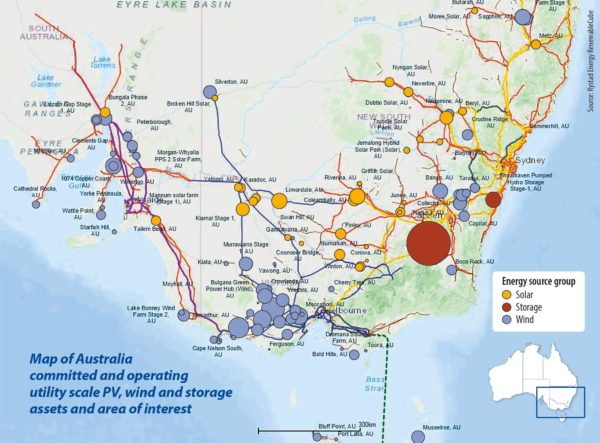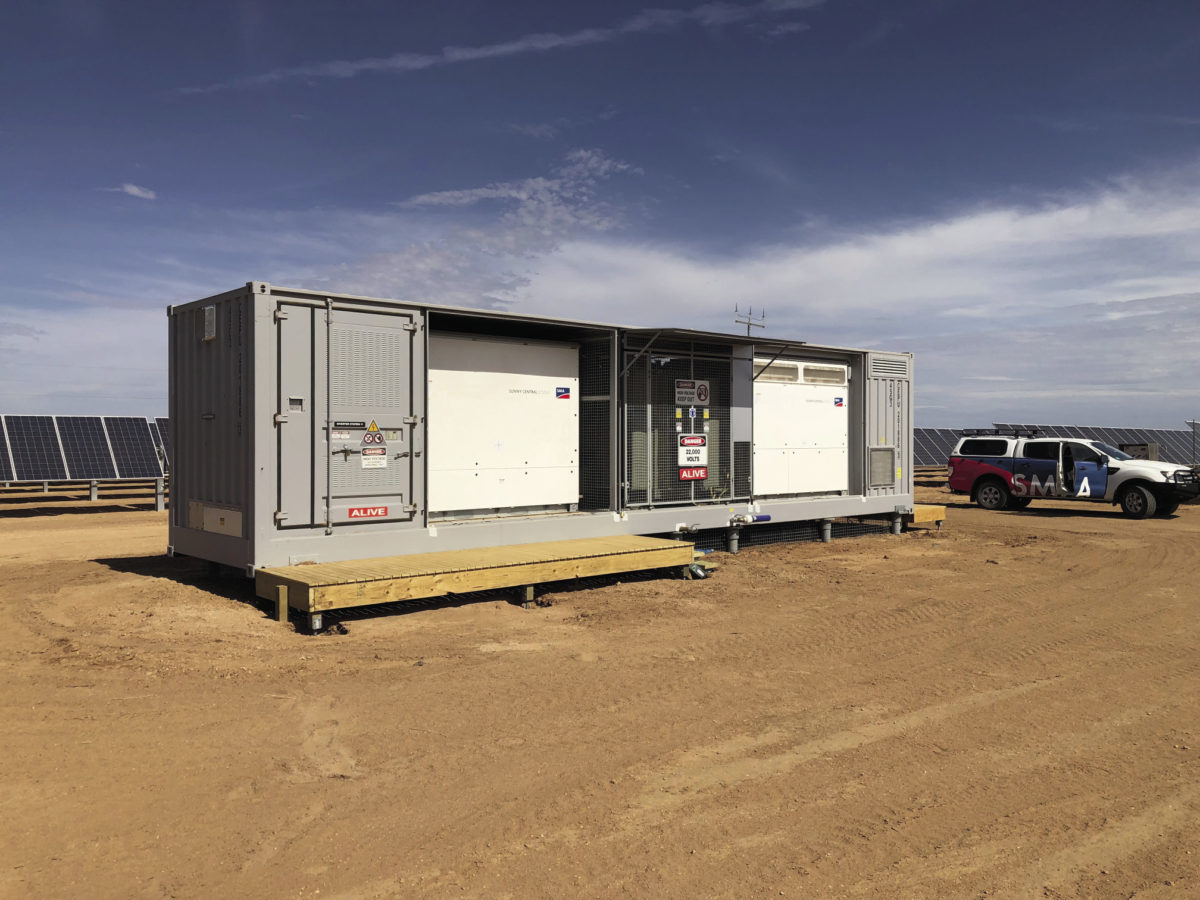From pv magazine 06/2020
In September 2019, five solar farms in the West Murray Zone (WMZ) were ordered to cut back their output to 50%, highlighting an emerging challenge for renewable energy generators on Australia’s main grid: system strength. The radical curtailment was ordered after it was discovered that the combined operations of the Bannerton, Broken Hill, Gannawarra, Karadoc, and Wemen solar farms were a source of uncontrollable voltage oscillations triggered by normal disturbances to the grid – such as lightning strikes (pv magazine 04/2020). In a ripple effect, the connection process of some 45 other solar PV and wind projects in the region came to a complete halt. Seven months later, life went back to normal in the WMZ – thanks to an inverter-based fix.
Following the successful testing of new control firmware and settings in late April, the Australian Energy Market Operator (AEMO) provisionally lifted constraints imposed on the five generators totaling more than 350 MW, allowing them to return to full export. The solution to the WMZ system strength issue involved tuning the plants’ inverters to operate in concert, rather than individually when delivering clean energy to the grid. With no new physical components or hardware changes used to engineer the solution, the inverter supplier to all five generators, Germany’s SMA, developed a new inverter capability to address a “live” problem on the grid.
For SMA, solving a problem by new firmware was actually nothing new. There have been smaller issues in many Australian PV plants, where either the customer wanted different performance or control, or else the grid operator wanted a plant to respond differently which led to new features in firmware.
“What was different this time is that, where previously changes were small or slighter modifications to firmware, the solution for West Murray was a completely new way of controlling how the inverter coordinates with and responds to the grid,” says Scott Partlin, who leads SMA Australia’s after-sales service. “This also held a significant amount of risk.” He goes to note that “abroad there have been similar instances through SMA’s almost 40-year history, but certainly none where the stakes for all involved parties were so high, and the outcome relying so heavily on SMA’s ability to deliver.“ The plant owners claimed that they were losing more than AU$100 million ($69 million) in revenue each day of curtailment.
As inverter manufacturers continue to build more advanced software features into their products to give grid operators more control and improve grid stability, outcomes like those in the WMZ are effectively changing the narrative around solar’s role on the grid. “The successful tests in West Murray are an important demonstration of the software capability of PV inverters and will give investors renewed confidence regarding the overall reliability of energy generation offered by solar plants,” says IHS Markit Solar Market Analyst Miguel De Jesus.
Lessons learned
The new voltage-tuning capability developed by SMA is giving greater ability to the market operator to time and control renewable generators on the grid – optimizing combined output. “This industry issue required an industry response to develop a solution that now reduces the likelihood of constraining inverter-based generators in low system strength areas,“ says Mark Shilliday, AEMO group manager, national connections.
The WMZ is not the only region in Australia facing system strength issues. AEMO had previously declared system strength shortfalls in South Australia, Tasmania, Victoria, and most recently in North Queensland – where two solar farms and one wind farm might have their output curtailed to zero.
It is safe to assume that if the curtailed generators were going through an AEMO connection process today, the system strength issues would be detected, and the generators would have an opportunity to address them before being given connection approval. But the problem was that too much solar PV generation was added to the grid network without detailed wide-area modeling.
As of February 2020, installed and commissioned generation in the WMZ was already at 1.7 GW. There are currently around 1.2 GW of committed wind and solar projects for connection in the region and about 3 GW in the application phase. The successful resolution of the system strength saga means that AEMO can now get on with the pipeline of renewable energy projects lying idle. Its goal is to have all committed projects in the region connected by early 2021, where possible.
“Since provisionally lifting generation constraints for the five solar farms in late April, AEMO has made good progress in the assessment for projects under commissioning,” Shilliday says. “A number of projects have been approved to proceed up to their final hold-point, testing and we are expecting to release all the remaining projects due for commissioning by first week of June.” AEMO will also be commencing the PSCAD integration studies for projects awaiting registration.

Collaboration is key
Undoubtedly the biggest takeaway was the importance of collaboration. The WMZ case proved technology will always outstrip regulation. This relationship is the primary reason why the problem arose in the first place and was also why, even once the solution was developed by SMA, there was still many months of work ahead in regulatory process to validate the solution before it could be used. Were it not for how all parties – AEMO, SMA, asset owners, network operators and consultants – chose to work together, there is every chance all five plants could have still been severely curtailed and no closer to finding a solution.
The need for collaboration is not simply restricted to the utility-scale space. The unstoppable growth of small-scale PV has already shown that joint efforts will be needed to address the new challenges facing the Australian grid.
“As solar accounts for a higher percentage of total energy generation in numerous markets globally, new advancements in areas such as artificial intelligence, cybersecurity and remote operation and maintenance will be increasingly important,” says IHS Markit Research Manager Cormac Gilligan. With their digital capabilities continuously improving, PV inverters are expected to become an asset to grid operators using advanced software to analyze and react to potentially disruptive events on the grid.
In Australia, grid integration challenges are continuing to mount. “We are leading the world on these issues, as the nature of our grid means we are dealing with the world’s problems of tomorrow, today,“ SMA’s Partlin says. “The solutions we develop together which are effective, the regulatory framework we create which delivers the desired outcomes, the way we chose to organize ourselves and work collaboratively are showing the rest of the world how they can address the same problems, when they begin to experience them in the decades ahead.”
This content is protected by copyright and may not be reused. If you want to cooperate with us and would like to reuse some of our content, please contact: editors@pv-magazine.com.









1 comment
By submitting this form you agree to pv magazine using your data for the purposes of publishing your comment.
Your personal data will only be disclosed or otherwise transmitted to third parties for the purposes of spam filtering or if this is necessary for technical maintenance of the website. Any other transfer to third parties will not take place unless this is justified on the basis of applicable data protection regulations or if pv magazine is legally obliged to do so.
You may revoke this consent at any time with effect for the future, in which case your personal data will be deleted immediately. Otherwise, your data will be deleted if pv magazine has processed your request or the purpose of data storage is fulfilled.
Further information on data privacy can be found in our Data Protection Policy.